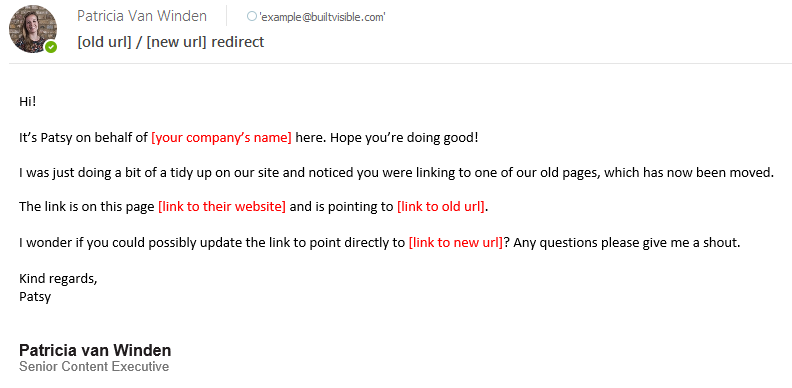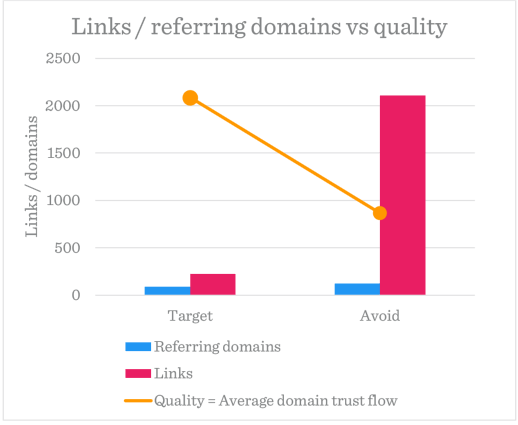The Results
Our aim was to minimise the impact of these changes on organic search performance. The complete absence of redirection from legacy domains would have resulted in broken user journeys and loss of authority flowing from hundreds of sites, including the likes of the BBC, Money Saving Expert and others.
Naturally, we began the process of auditing and realigning external links, starting with the most valuable (we’ll explore our process in-depth shortly). Yet as we tackled these risks and scaled up our outreach to authoritative websites, something else happened.
The client’s visibility jumped by 20% site-wide.

In this case, the 20% increase in visibility adhered to the time-honoured SEO mantra of results occurring 2-3 months after the work started. During this time the brand did not:
- Gain natural links at a velocity higher than normal
- Undertake any site-wide technical or on-site changes
- Improve targeting across pages affected by the visibility boost
Note the visibility in this case was based on a previously agreed-upon set of over 1,000 relevant, non-brand keywords.
Interestingly, one of the products had a much healthier legacy profile than the others. Because we track visibility by keyword set, we were able to see that the 500 keywords related to that product saw a greater boost than the site-wide improvement – 33% in total.

For a project which was originally briefed in as a risk mitigation exercise, these were extremely positive results. The visibility jump wasn’t the last surprise in store, however.
Before we get to that – and to the controversy surrounding equity loss from redirects – let’s talk about our approach.
The Approach
First, we pulled together a list of URLs pointing to the old domains using data from Majestic and Ahrefs. We filtered that list down to domains with a Trust Flow greater than 10. We then grabbed contact details for each.
Trust Flow is a metric largely used to understand the quality of links pointing at a domain, and therefore the value that can be passed from it. So, if there are authoritative backlinks to a site, we’d see a greater Trust Flow.
We also had a few legacy documents that detailed the sites’ backlink profiles at point of migration, with some due diligence completed on toxic links. We also took those and compared them against the legacy disavow file.
We decided to start at the top with the most authoritative links and invest more time in realigning these. After identifying the opportunities, it was then time to reach out and ask for those links to be updated. Making sure the e-mail was concise and personalised, we used this template by Patsy:

By focusing on the most authoritative domains and completing several rounds of outreach, we were able to reclaim links from 60% of the powerful domains we reached out to, including Money Saving Expert and the BBC. These are links that would otherwise have broken completely had the legacy domain retirement plan gone ahead without SEO oversight.
This chart illustrates how our prioritised approach focused on the biggest opportunities:

Please Note: Averaging logarithmic scales such as Trust Flow and Moz Domain Authority can be highly misleading – between each point in the scale there is essentially a multiplication operation, meaning that the difference between two consecutive points at the upper end of the scale will be exponentially bigger than two such points at the lower end.
Loss of Legacy Redirects
Soon after the site saw the 20% boost to visibility correlated with link realignment, the client’s developers cut the legacy redirects quite suddenly. The main bulk of the link profile had not been updated at this point.
What followed was a period of day-to-day visibility fluctuation lasting several weeks, followed by a gradual improvement over subsequent months. On top of an overall improvement in visibility of 16-20%, a number of high-volume keywords for which the client had previously sat on page 2 have now crept onto page 1.

Discussion: Is PageRank lost through 3XX redirects?
Now for the controversial part. Pre-2016, SEOs tended to agree that you lost about 15% of PageRank through a 301 redirect. However, in 2016 John Mueller announced that no PageRank is lost through 301 or 302 redirects. Read more about it in Cyrus Shepard’s write-up or Google’s statement.
Whether or not redirects cause a loss or dilution of PageRank, there are a number of explanations for why link realignment may still have observable benefits:
- Upon discovering a realigned link, Googlebot treats it as an entirely new and fresh signal, rather than treating it as a one-to-one replacement for the redirect. It re-evaluates all signals within the modern context of the page, with the result that the new link sends stronger signal than before.
- In Google’s eyes, the brand could have become an entirely new entity when it moved away from the old sites. Google considers both context and relevance when assessing a link, and in many instances the context of the legacy links was updated along with the links themselves (with new and appropriate branding, anchor text, logo, product names, etc).
As is often the case with SEO, there is no way to prove or disprove these theories with any certainty. Instead, we can only watch for patterns and correlations, and are left to draw our own conclusions.
What we can say in this scenario is that realignment of legacy links had a measurable effect on organic search visibility, and that this had significant knock-on effects on traffic, leads and sales.
Link realignment projects (and the outreach they entail) can seem daunting and unrewarding; they are labour intensive, and the benefits may not be immediately observable. However, with careful prioritisation, consistent execution, and rigorous measurement, they can often yield tremendously positive results.

Venkat Reddy
Great article on gaining edge in SEO when it comes to pointing the external links in the right way. Though this is very true that there are no proof documents behind the conclusion but the study do reflect the same.
Luke Berry
Thanks for the kind words Venkat
David Iwanow
I really love this post, I’ve always pushed the strategy of updating your best links when possible!
Morgan
Great study! Whats your approach when reaching out to large sites, such as BBC? Do you find more success by reaching out to the writer, editor or general email?
Luke Berry
Hi Morgan – I can’t speak for Patsy in this case, I have found generally for large sites a webmaster/admin style email is usually the most effective.
Michael
I think that basic facts in this case study can be true and it is for a sure like that – the algorithm of google but still there can be a trap and it is that to see some changes after playing with link profile it tooks a time – and noone exactly know how much time it is. If it is few weeks or 2-3 months or more.
Meenal Rathod
excellent article!
one of the decent ones I have came across.
worth a read.